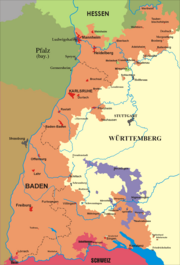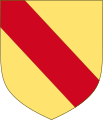
The House of Zähringen was a dynasty of Swabian nobility. The family's name derived from Zähringen Castle near Freiburg im Breisgau. The Zähringer in the 12th century used the title of Duke of Zähringen, in compensation for having conceded the title of Duke of Swabia to the Staufer in 1098. The Zähringer were granted the special title of Rector of Burgundy in 1127, and they continued to use both titles until the extinction of the ducal line in 1218.

Baden-Baden is a spa town in the state of Baden-Württemberg, south-western Germany, at the north-western border of the Black Forest mountain range on the small river Oos, ten kilometres east of the Rhine, the border with France, and forty kilometres north-east of Strasbourg, France.

The history of Baden-Württemberg covers the area included in the historical state of Baden, the former Prussian Hohenzollern, and Württemberg, part of the region of Swabia since the 9th century.

The Margraviate of Baden was a historical territory of the Holy Roman Empire. Spread along the east side of the Upper Rhine River in southwestern Germany, it was named a margraviate in 1112 and existed until 1535, when it was split into the two margraviates of Baden-Durlach and Baden-Baden. The two parts were reunited in 1771 under Margrave Charles Frederick, even if the three parts of the State maintained their distinct seats to the Reichstag. The restored Margraviate of Baden was elevated to the status of electorate in 1803. In 1806, the Electorate of Baden, receiving territorial additions, became the Grand Duchy of Baden. The rulers of Baden, known as the House of Baden, were a cadet line of the Swabian House of Zähringen.

Niefern-Öschelbronn is a municipality in the Enz district, in Baden-Württemberg, Germany. It is situated on the river Enz, 6 km east of Pforzheim.

Löchgau is a municipality in the Ludwigsburg district of Baden-Württemberg, Germany.

The coat of arms of the German state of Baden-Württemberg features a greater and a lesser version.
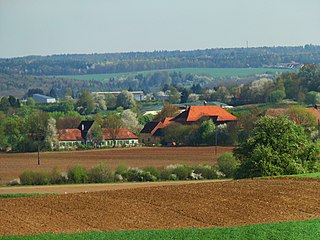
Eisingen is a municipality in the district of Enz in Baden-Württemberg in Germany. It is situated on the Bertha Benz Memorial Route and contains no other villages.
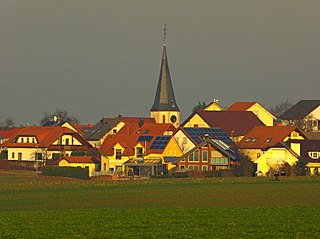
Neulingen is a municipality in the Enz district in Baden-Württemberg in Germany. It was created on 1 January 1974 from the three independent villages of Bauschlott, Göbrichen, and Nußbaum. It is located on Bertha Benz Memorial Route.
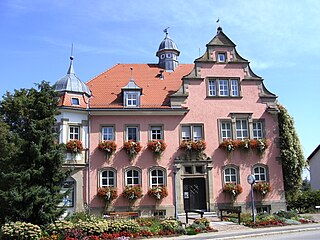
Dauchingen is a municipality in the district of Schwarzwald-Baar in Baden-Württemberg, Germany.
This is a list of coats of arms of Germany.

The flag of Baden displayed a combination of yellow and red, the heraldic colours of the former German state of Baden.

The coat of arms of the Kingdom of Württemberg shows an impalement of the three black antlers that represent Württemberg on the dexter side, and the three black lions passant of medieval Swabia on the sinister side, both on a gold field.

The Margraviate of Baden-Durlach was an early modern territory of the Holy Roman Empire, in the upper Rhine valley, which existed from 1535 to 1771. It was formed when the Margraviate of Baden was split between the sons of Margrave Christopher I and was named for its capital, Durlach. The other half of the territory became the Margraviate of Baden-Baden, located between the two halves of Baden-Durlach. Baden-Durlach became Lutheran during the Protestant Reformation, unlike Baden-Baden, which remained Catholic. Baden-Durlach occupied Baden-Baden from 1594 to 1622, but was driven out after being defeated at the Battle of Wimpfen, during the Thirty Years' War (1618-1648). The territory was ravaged during the Nine Years' War (1688-1697). Following the extinction of the Baden-Baden line in 1771, the Baden-Durlach inherited their territories and reunited the Margraviate of Baden. The reunified territory was caught up in the French Revolutionary and Napoleonic Wars, emerging in 1806 as the Grand Duchy of Baden.

Baden is a historical territory in South Germany. In earlier times it was considered to be on both sides of the Upper Rhine, but since the Napoleonic Wars, it has been considered only East of the Rhine.

Württemberg is a historical German territory roughly corresponding to the cultural and linguistic region of Swabia. The main town of the region is Stuttgart.
Baden is the western part of the German state of Baden-Württemberg, named for Baden-Baden, which was named for its hot springs.

The Grand Duchy of Baden was a state in south-west Germany on the east bank of the Rhine. It existed as a sovereign state between 1806 and 1871 and as part of the German Empire from 1871 until 1918.

